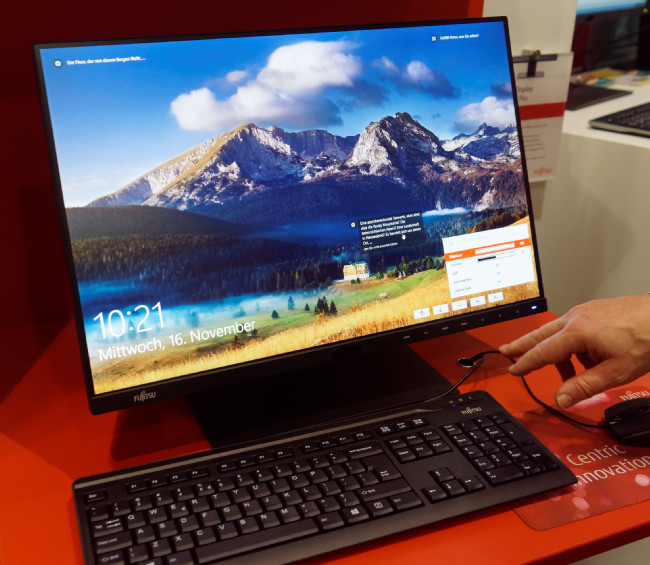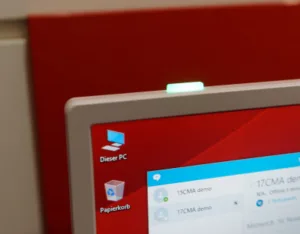We spent time looking at the new monitors. The first we looked at, the P24-8 TE Pro, was the production version of a set that we reported on two years ago and that has an LED on the top that is designed to work with Microsoft Skype for Business (Lync). When a headset is plugged into a system, there is no audible warning of an incoming call if the user is not wearing the headset. Fujitsu has developed the monitor (a 23.8″ 16:9 FullHD set with 250 cd/m²) that connects to Skype and flashes the LED when an incoming call arrives – a very convenient and low cost add-on for call centres. The monitor started shipping a few weeks ago.
Fujitsu has this Skype for Business lamp which indicates when a call is coming in. Image:Meko
Last year, we heard of some tenders that mandated cameras in the monitor, also for use with Skype for Business, but Fujitsu shares our view on the difficulties of doing this well. In Germany, in particular, the expectation is that video camera must be able to be physically blocked, because of concerns over privacy. Further, it may be less easy than with a notebook to adjust the line of sight of the camera to catch the user. Finally, monitors are increasingly designed with narrow bezels which makes it hard to fit a camera.
 The new Fujitsu P Series Monitor has narrow bezels. Image:Meko
The new Fujitsu P Series Monitor has narrow bezels. Image:Meko
On the subject of narrow bezels (how smoothly did we do that? Man. Ed.), Fujitsu was showing new “P” line top of the range monitors in 24″ (16:10, 1920 x 1200) and 27″ (2560 x 1440) with narrow bezels of 6mm and 8mm respectively. The borders are very narrow on the top and sides, but not on the bottom as Fujitsu likes to have physical controls (including a power light) for the user.
The P24-8 WS Pro has 300 cd/m² of output and 1,000:1 contrast, with 5ms response time (grey to grey). Height adjustment is 130mm and there are DisplayPort 1.2, HDMI 1.4 and DVI-D (HDCP) inputs and the DisplayPort has a daisy chain function. The monitor has dual 1.5W speakers and an integrated USB hub.
The controls are also screen printed to show their function as the firm has found that it has a number of clients that like this simplicity and find the trend to very ‘pure’ bezels leads to confusion for users. The monitors have presence sensors and the OSD has new functions that allow the management of the sensor and other functions such as setting the minimum brightness when the automatic brightness control is in operation. The OSD can also set the timings of the presence sensor and control whether it also sets the security on the host PC as well as blanking the display.
The monitors look good and have dark casing (although versions with a light outer option will also be available, later) and they have a very ‘clean’ design on the rear without the prominent logos that some other companies use. Performance on the monitors looks good, with IPS panels being used, and with calibration at a delta E of less than 2.0 for good uniformity and colour.

